Executive summary
Hello everyone, this time we share 24 instruments in 4 categories, including the dynamic structure diagram, principle introduction and advantages and disadvantages of each instrument. These include: 12 kinds of flowmeters, 3 kinds of thermometers, 5 kinds of pressure gauges, and 4 kinds of liquid level gauges. If you like, welcome to share with friends in the circle!
Flow meter (12 types)
Target flowmeter, orifice flowmeter, vertical lumbar flowmeter, flowmeter calibration, nozzle flowmeter, volumetric flowmeter, elliptical gear flowmeter, venturi flowmeter, dual rotor gas flowmeter, turbine flowmeter Rotor flowmeter, throttle flowmeter, electromagnetic flowmeter
Thermometer (3 types)
Solid expansion thermometer, thermocouple thermometer, pressure thermometer
Pressure gauge (5 types)
Spring tube pressure gauge, electric contact pressure gauge, capacitive pressure sensor, strain gauge pressure sensor, U-tube pressure gauge
Level gauge (4 types)
Differential pressure level gauge, ultrasonic measuring liquid level principle, capacitive liquid level gauge, double liquid level differential pressure gauge
Flow meter
First, the orifice flowmeter
The orifice flowmeter is a high-range differential pressure flow device that combines a standard orifice plate with a multi-parameter differential pressure transmitter (or differential pressure transmission, temperature transmitter and pressure transmitter) to measure gas and steam. , liquid and natural gas flow. Widely used in process control and measurement in petroleum, chemical, metallurgy, electric power, heating, water supply and other fields. Orifice flowmeter is widely used in various fields of the national economy such as coal, chemical industry, transportation, construction, textile, food, medicine, agriculture, environmental protection and people's daily life. It is the development of industrial and agricultural production, saving energy and improving product quality. Important tools to improve economic efficiency and management level play an important role in the national economy. In process automation instruments and devices, flow meters have two functions: as a test instrument for the process automation control system and a total meter for measuring the quantity of materials.
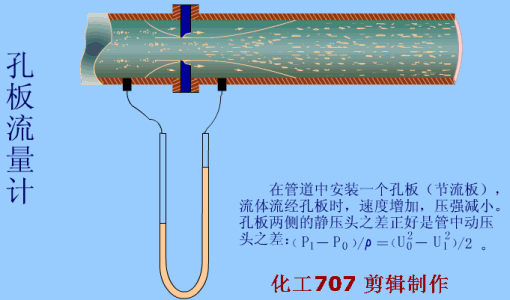
Features:
advantage:
1. The standard throttle is fully used and approved by the International Standards Organization. It can be used without actual flow calibration and is unique in the flow sensor.
2, the structure is easy to copy, simple, firm, stable and reliable performance, low price;
3, a wide range of applications, including all single-phase fluid (liquid, gas, steam), part of the mixed phase flow, the diameter of the general production process, working conditions (temperature, pressure) can be measured;
4. The test piece and the differential pressure display instrument can be separated from different manufacturers and produced with professional scale.
Disadvantages:
1. The repeatability and accuracy of the measurement are moderate in the flow sensor. Due to the intricacies of many factors, the accuracy is difficult to improve;
2, the range is narrow, because the flow coefficient is related to the Reynolds number, the general range is only 3:1 ~ 4:1;
3. There is a long straight pipe length requirement, which is generally difficult to meet. Especially for larger pipe diameters, the problem is more prominent;
4, the pressure loss is large;
5, the orifice plate with the acute angle of the inner hole to ensure the accuracy, so the sensor is sensitive to corrosion, wear, scaling, dirt, long-term use accuracy is difficult to guarantee, need to remove the strong inspection once a year;
6, the use of flange connection, easy to run, run, drip, leak problems, greatly increased the maintenance workload.
Second, the vertical waist flowmeter
The lumbar flowmeter is also called a Roots flowmeter. Its structural feature is that there is a metering chamber in the housing of the flowmeter. There are one or two pairs of waist wheels that can rotate tangentially in the measuring chamber. A pair of transmission gears are coaxially mounted on the outside of the flowmeter housing with the two search wheels, and they mesh with each other so that the two waist wheels can be interlocked with each other. The waist wheel flowmeter can be used for flow measurement of various cleaning liquids, especially for oil metering, and can also be used as a flow meter for measuring gas. Its metering accuracy is high, up to 0.1-0.5.
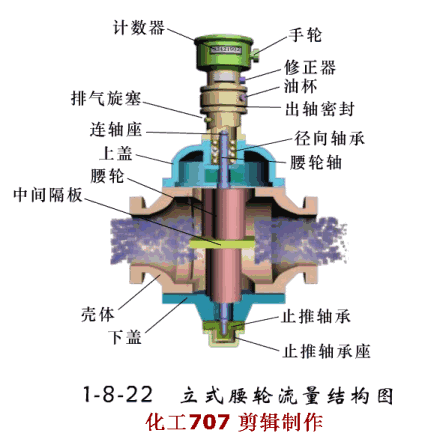
Features:
The waist wheel flowmeter has novel design and beautiful appearance. It has the characteristics of light weight, high precision, convenient installation and use. It is one of the typical products of positive displacement flow meters. The main shortcomings are: large volume, heavy weight, large pressure loss, large vibration during operation, etc. The use of two pairs of waist-wheel structures with a 45-degree angle can greatly reduce the vibration noise during operation.
Third, volumetric flowmeter
Volumetric flowmeters, also known as fixed displacement flowmeters, referred to as PD flowmeters, are among the most accurate in flowmeters. It utilizes a mechanical measuring element to continuously divide the fluid into a single known volume portion, and measures the total volume of the fluid based on the number of times the measuring chamber repeatedly fills and discharges the volume of the fluid one by one. Volumetric flowmeters are classified into elliptical gear flowmeters, scraper flowmeters, dual-rotor flowmeters, rotary piston flowmeters, reciprocating piston flowmeters, disk flowmeters, and liquid-sealed rotary flowmeters. , wet gas meter and membrane gas meter.
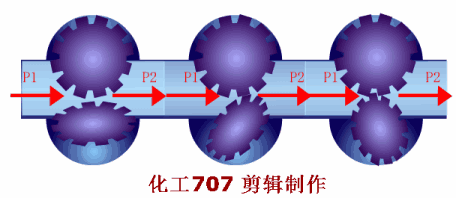
Features:
advantage:
(1) High measurement accuracy;
(2) Installation pipeline conditions have no effect on the measurement accuracy;
(3) It can be used for the measurement of high viscosity liquids;
(4) The range is wide;
(5) Direct-reading instruments can be directly accumulated without external energy, and the total amount is clear and easy to operate.
Disadvantages:
(1) The structure is complex and bulky;
(2) The type of the tested medium, the caliber, and the working state of the medium are more limited;
(3) Not suitable for high and low temperature applications;
(4) Most instruments are only suitable for clean single-phase fluids;
(5) Noise and vibration are generated.
Fourth, oval gear flowmeter
The elliptical gear flowmeter (also known as the displacement flowmeter and the gear flowmeter) is a type of volumetric flowmeter, and it is a class of high precision in the flowmeter. It utilizes a mechanical measuring element to continuously divide the fluid into a single known volume portion, and measures the total volume of the flow volume based on the number of times the metering chamber successively and repeatedly fills and discharges the volume of the fluid. The elliptical gear flowmeter can be made of different materials (cast iron, cast steel, 304 stainless steel, 316 stainless steel). It is especially suitable for flow measurement of high viscosity medium such as heavy oil, polyvinyl alcohol and resin.

Features:
The oval gear flow meter installed correctly according to the requirements can ensure sufficient accuracy when used. Generally, the accuracy of the accumulated value can reach 0.5, which is a more accurate flow meter. However, if the flow rate of the measured medium is too small during use, the influence of the leakage error of the meter will be prominent, and sufficient measurement accuracy cannot be guaranteed. Therefore, the elliptical gear flowmeters of different models and sizes have an allowable value for the minimum use flow rate, and the measurement accuracy can be ensured only when the actual measured flow rate is greater than the allowable value of the lower limit flow rate.
Secondly, the use of the elliptical gear flowmeter should pay attention to the temperature of the measured medium can not be too high, otherwise it will not only increase the measurement error, but also the possibility of the gear jam. For this purpose, the elliptical gear flowmeter is used within the operating temperature range specified by the instrument.
After long-term use of the elliptical gear flowmeter, the internal gears will be corroded and worn, which will affect the measurement accuracy. Therefore, always pay attention to observation, and regularly remove it for inspection. If conditions permit, it is best to perform calibration regularly.
Five, venturi flowmeter
The basic measurement principle of the new generation of differential pressure flow measuring instruments is the flow measurement method based on the law of conservation of energy - the primary effort equation and the flow continuity equation. The inner venturi consists of a circular measuring tube and a special core placed in the measuring tube and coaxial with the measuring tube. The radially outer surface of the special core has a geometric profile similar to the inner surface of a classic venturi and forms a differentiating annular overcurrent gap with the inner surface of the measuring tube. The throttling process of the fluid flowing through the inner venturi is substantially similar to the throttling process of the fluid flowing through the classic venturi and annular orifice. This structural feature of the Nevin tube prevents the sharp edge erosion and fouling of the orifice plate in the process of use, and can provide a gradient of the fluid velocity distribution in the pipe before throttling and various possible The non-axisymmetric velocity profile performs effective flow regulation (rectification), enabling high accuracy and high stability flow measurements.
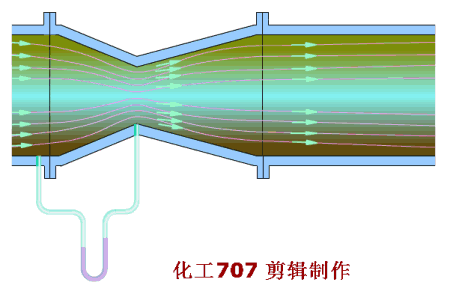
Features:
Advantages: If it can be accurately manufactured according to ASME standards, the measurement accuracy can reach 0.5%, but the domestic venturi is difficult to guarantee due to its manufacturing technology problems. The domestically qualified technical force of Kaifeng Instrument Factory can only guarantee 4 % Measurement accuracy, for the condition of ultra-supercritical power generation, the pressure equalization ring at the throat is a dangerous link under high temperature and high pressure. If the pressure equalization ring is not used, it will not meet the ASNE ISO5167 standard, and the measurement accuracy will be There is no guarantee that this is a contradiction in the manufacture of high-pressure classic venturi.
Disadvantages: The throat is the same material as the inlet/outlet, and the fluid is severely scoured and worn against the throat, which cannot guarantee long-term measurement accuracy. The length of the structure must be manufactured in accordance with ISO-5167, otherwise the required accuracy will not be achieved. Due to the strict structural requirements of the classic venturi of ISO-5167, the maximum/minimum flow ratio of the flow measurement range is small, generally at 3 – Between 5 and 5. It is difficult to meet the flow measurement with large flow changes.
Six, double rotor gas flowmeter
The dual-rotor flowmeter belongs to the latest generation of volumetric flowmeters in the world, also known as UF-‖ flowmeter or screw flowmeter. It is a precision instrument for the measurement and control of liquid flow in pipes. Widely used in petroleum, chemical, metallurgy, electric power, transportation, ships, oil depots, docks, tank trucks and other departments, especially for metering flowmeters of industrial liquids such as crude oil, refined oil, light hydrocarbons, etc., can be on-site indication, the words are directly read and It can be equipped with a transmitter, output electrical pulse signal, and transmitted to a secondary instrument or computer to form an automatic control, automatic detection and data processing system.

Features:
Applicable to thin oil, light oil, heavy oil, crude oil with large sand content and large water content, the viscosity range of the liquid to be measured is large.
The flow rate of the liquid passing through the flow meter is large, and the maximum flow rate is about twice that of the common volume meter of the same diameter.
Long service life, high accuracy and reliability.
The internal pressure loss is minimal.
The longest distance of the wired remote transmission is 1000 meters, and the pulse signal output is N=0.1L (one pulse is 1N), which can be directly connected to the computer.
Seven, turbine flowmeter
The intelligent liquid turbine flowmeter is a new type of intelligent flowmeter integrated with the display of integrated flowmeter and turbine flowmeter developed by advanced ultra-low-power single-chip microcomputer technology. It is the main type of speed flowmeter when the measured fluid flows through the turbine. When the flowmeter sensor is used, under the action of the fluid, the impeller is rotated by force, and its rotation speed is proportional to the average flow velocity of the pipeline. At the same time, the blade periodically cuts the magnetic flux generated by the electromagnet and changes the magnetic flux of the coil. According to the principle of electromagnetic induction, the coil is The internal pulsating potential signal, that is, the electrical pulse signal, is generated, and the frequency of the electrical pulsation signal is proportional to the flow rate of the fluid to be measured.
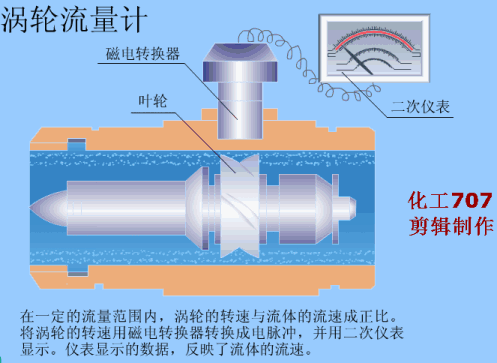
Features:
The utility model has the advantages of compact mechanism, intuitive and clear reading, high reliability, no external power interference, lightning strike resistance and low cost.
Eight, rotameter
A float flowmeter, also known as a rotameter, is a device that estimates flow by measuring the position of a rotating component placed in a DC pipe. It is a kind of variable area flowmeter. In a vertical cone that expands from bottom to top, the gravity of the circular cross-section float is absorbed by the liquid power, and the float can freely rise and fall within the cone. It moves up and down under the action of flow velocity and buoyancy, and after balancing with the weight of the float, it is transmitted to the dial and indicated by the magnetic coupling. Generally divided into glass and metal rotameters. The metal rotameter is the most commonly used in the industry. For small diameter corrosive media, glass is usually used. Due to the fragility of the glass material, the key control points are also made of precious metal such as titanium. .
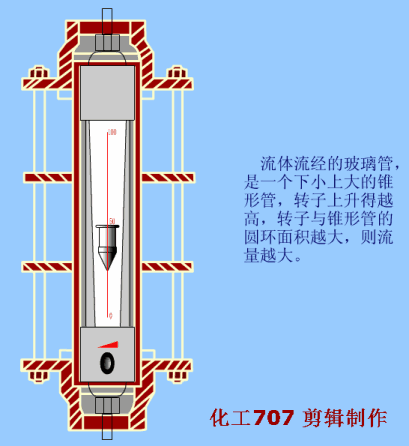
Features:
Rotameters are one of the most commonly used flow meters in industry and in laboratories. It has the characteristics of simple structure, intuitive, small pressure loss and convenient maintenance. Rotameters are suitable for measuring small flows through pipe diameters D < 150 mm, as well as for corrosive media. In use, the flow meter must be mounted on a vertically running pipe section and the fluid medium passes through the rotameter from bottom to top. It has small pressure loss and large turndown ratio (10:1). It is easy to install and maintain. It can be widely used in flow measurement and process control in complex, harsh environments and various media conditions.
Nine, target flowmeter
The target flowmeter was applied to industrial flow measurement in the 1960s. It is mainly used to solve the flow measurement of high viscosity and low Reynolds number fluid. It has experienced two development stages of pneumatic and electric meters. SBL series intelligent target flowmeter Based on the measurement principle of the original strain gauge (capacitive) target flowmeter, the new type of force-sensing sensor is used as the measurement and sensitive transmission component, and a new type of flow developed by modern digital intelligent processing technology is developed. Metering instrument.

Features:
1. The whole instrument structure is solid and has no moving parts, and the plug-in structure is easy to disassemble;
2, can choose a variety of anti-corrosion and high temperature resistant materials (such as Hastelloy, titanium, etc.);
3, the whole machine can be made into a full seal without dead angle (welding form), without any leakage point, can withstand 42MPa high pressure;
4. The self-inspection program is set in the instrument, and the fault phenomenon is clear at a glance;
5. The sensor is not in contact with the measured medium, there is no wear of the parts, and the use is safe and reliable;
6, can be used on the local dry calibration method, that is, using the weight hanging method. One-button operation can complete the calibration;
7, with a variety of installation methods to choose from, such as the choice of online plug-in, installation costs are low;
8, with integrated temperature, pressure compensation, direct output quality or standard;
9, with optional small signal cutoff, nonlinear correction, filter time can be selected;
10. It can accurately measure the flow of gas and liquid under various normal temperature, high temperature 500 degree and low temperature-200 degree working conditions;
11, accurate measurement, accuracy can reach 0.2%;
12, good repeatability, generally 0.05% to 0.08%, fast measurement;
13, the pressure loss is small, only about 1/2 ΔP of the standard orifice plate;
14, anti-interference, anti-impurity ability is extremely strong;
15. The flow block can be changed according to actual needs to change the flow block (target piece);
16. Low-power battery on-site display, which can directly read the indication value online, and the display can simultaneously read the instantaneous and cumulative flow rate and the percentage bar graph;
17, easy to install, easy to maintain;
18, a variety of output forms, can pass a variety of parameters;
19, strong anti-vibration, pulsating flow can be measured within a certain range.
Ten, nozzle flowmeter
The nozzle flowmeter is a differential pressure generating device that measures flow. It can measure the flow of various fluids in the pipeline with various differential pressure gauges or differential pressure transmitters. The standard nozzle throttling device is used with the differential pressure transmitter to measure the flow of liquid, steam and gas. It is widely used in petroleum, chemical, metallurgy, electric power, light industry and other departments.
The one-piece installation consists of a smart display (multi-parallel transmitter) and a nozzle unit that together form a nozzle flow meter. It comes with a high quality differential pressure sensor, pressure sensor, and thermal resistance temperature sensor. The AW2003-type intelligent display (multi-parallel transmitter) not only automatically adapts to the range of the differential pressure sensor, but also various compensation coefficients such as the outflow coefficient C and the beam expansion coefficient ε are all calculated online, which truly expands. The measurement range ensures the accuracy of the measurement. The large-screen LCD displays the cumulative flow, instantaneous flow, instantaneous pressure, and instantaneous temperature on the same screen without manual switching. 4-20mA two-wire instantaneous flow output. It is divided into two categories: intrinsically safe explosion-proof products and ordinary products. The split installation consists of a separate nozzle unit, differential pressure, pressure, temperature transmitter, flow calculator, and shut-off valve. The connection combination between the parts is done by the user himself.

Features:
Compared with orifice flowmeters, nozzle flowmeters have less pressure loss, which saves energy, is more rugged and durable, is suitable for high temperature and high pressure fluids, and is widely used for steam flow measurement in electric power, chemical and other industries. Nozzle flowmeters include standard nozzles (ISA 1932 nozzles) and long neck nozzles. Its design and manufacture are in line with the international standard ISO5167 or the national standard GB/T2624.
Eleven, throttle flowmeter
The flow pipe of the gas is equipped with a throttling device, which is provided with an orifice plate, and a circular hole is formed in the center, the pore diameter is smaller than the inner diameter of the pipe, and the gas flows stably forward in front of the orifice plate, and the gas flows through the orifice plate due to The pore diameter becomes smaller, the cross-sectional area shrinks, and the steady flow state is disturbed, so the flow rate will change, the speed will increase, and the static pressure of the gas will decrease accordingly, so that a pressure drop occurs before and after the orifice plate, that is, differential pressure (the front section of the orifice plate is large) The pressure in the place is large, and the pressure is small through the small section of the orifice plate). The magnitude of the differential pressure and the gas flow have a certain numerical relationship, that is, when the flow rate is large, the differential pressure is large, and when the flow rate is small, the differential pressure is small. The flow is proportional to the square root of the differential pressure. The throttling flowmeter is a meter that calculates the flow rate based on the differential pressure generated by the flow detecting member installed in the pipe, the known fluid condition, and the geometrical dimensions of the detecting member and the pipe.

Features:
The throttling flowmeter is a typical differential pressure flowmeter. It is the most commonly used flow meter for measuring gas, liquid and vapor flow in industrial production. According to the survey statistics, the flowmeters used in industrial production systems such as steel mills and refineries are (70-80)%, which are throttling flowmeters. In the entire industrial production field, throttling flow meters also account for more than half of the total number of flow meters. The throttling flowmeter is so widely used, mainly because it has two very prominent advantages:
1. Simple structure, convenient installation, reliable work, low cost and certain accuracy. Can meet the needs of engineering measurement.
2. Has a long history of use, rich and reliable experimental data, design and processing has been standardized. As long as the throttling flowmeter designed and manufactured according to the standard does not need to be physically calibrated, the flow measurement can be performed within the known uncertainty range.
In particular, the second advantage makes the throttling flowmeter very convenient in manufacturing and use. Because of the flow rate of a flow meter, especially for large flow measurement, there will be various difficulties in the inspection.
Twelve, electromagnetic flowmeter
Electromagnetic flowmeter is a new type of flow measuring instrument developed rapidly with the development of electronic technology in the 1950s and 1960s. An electromagnetic flowmeter is an instrument that applies the principle of electromagnetic induction to measure the flow of a conductive fluid based on the electromotive force induced by the conductive fluid through an applied magnetic field.
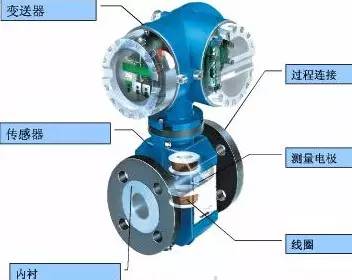
Characteristics
1. Measurement is not affected by changes in fluid density, viscosity, temperature, pressure, and conductivity;
2. Unobstructed flow components in the measuring tube, no pressure loss, and low requirements for straight pipe sections. Unique adaptability to slurry measurement;
3. Reasonable selection of sensor lining and electrode materials, that is, good corrosion resistance and wear resistance;
4. The converter adopts novel excitation mode, low power consumption, stable zero point and high precision. The flow range can reach 150:1;
5. The converter can be integrated with the sensor or separated;
6. The converter adopts 16-bit high-performance microprocessor, 2x16LCD display, convenient parameter setting and reliable programming;
7. The flowmeter is a two-way measuring system with three totalizers: positive total, reverse total and total difference; can display positive and negative flow, and has multiple outputs: current, pulse, digital communication , HART;
8. The converter adopts surface mount technology (SMT) with self-test and self-diagnosis function;
9. Measurement accuracy is not affected by changes in fluid density, viscosity, temperature, pressure and conductivity. The sensor induced voltage signal is linear with the average flow rate, so the measurement accuracy is high.
10. There is no obstruction in the measuring pipe, so there is no additional pressure loss; there is no moving parts in the measuring pipe, so the sensor has a very long life.
11. Since the induced voltage signal is formed in the entire space filled with the magnetic field and is the average value on the pipeline surface, the sensor requires a short straight pipe section and a pipe diameter of 5 times.
12. The converter adopts the latest and most advanced single-chip microcomputer (MCU) and surface mount technology (SMT). It has reliable performance, high precision, low power consumption, stable zero point and convenient parameter setting. Click on the Chinese display LCD to display cumulative flow, instantaneous flow, flow rate, flow percentage, and more.
13. Two-way measurement system, which can measure forward flow and reverse flow. Special production processes and high-quality materials ensure that the performance of the product remains stable for a long time.
thermometer
Thirteen, solid expansion thermometer
Expansion thermometer
The temperature measurement of the expansion thermometer is based on the principle that the object expands when heated, and can be divided into liquid expansion type and solid expansion type. Here is an introduction to the introduction of a bimetallic thermometer in a solid expansion thermometer.
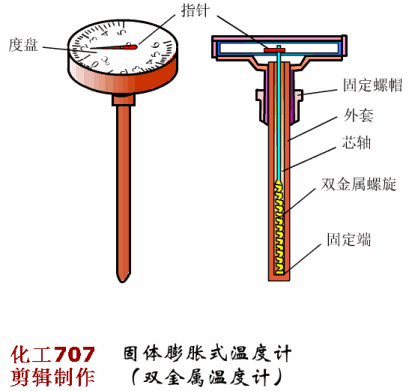
Bimetallic thermometer
The bimetal thermometer is made by welding two metal foils with different expansion coefficients. It is a solid expansion thermometer with a simple and firm structure. Bimetal thermometers convert temperature changes into mechanical quantities, not only for temperature measurement, but also for temperature control devices (especially for "on-off" control of switches). They are used in a wide range of applications.
Fourteen, thermocouple thermometer
The thermocouple thermometer is a widely used temperature measuring device in industrial production. Two different conductors (called thermocouple wire or hot electrode) are joined at both ends into a loop. When the temperature of the joint is different, an electromotive force is generated in the loop. This phenomenon is called thermoelectric effect. The electromotive force is called the thermoelectric potential. Thermocouples use this principle for temperature measurement. The one that is directly used to measure the temperature of the medium is called the working end (also called the measuring end), the other end is called the cold end (also called the compensating end); the cold end and the display The instrument or the supporting instrument is connected, and the display meter indicates the thermoelectric potential generated by the thermocouple.
The thermocouple sensing element is composed of two metal wires of different materials, and has a simple structure, convenient use, high precision, wide measuring range and anti-vibration, and is suitable for medium and high temperature temperature zones.
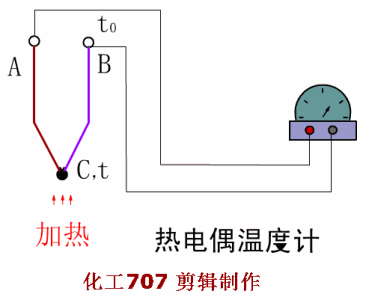
Features:
advantage:
1. High measurement accuracy. Because the thermocouple is in direct contact with the object to be tested, it is not affected by the intermediate medium.
2. Wide measurement range. Commonly used thermocouples can be continuously measured from -50 to +1600 °C. Some special thermocouples can measure -271--+2800 °C such as gold-iron nickel-chromium and tungsten-bismuth.
3. Simple structure and easy to use. Thermocouples are usually made up of two different wires and are not limited by size and opening. They have a protective sleeve and are very convenient to use.
4. The output signal is linear and convenient to realize the automation of industrial production process.
Disadvantages:
The differential thermal potential is small, so the sensitivity is low; the price is relatively expensive, the mechanical strength is low, and it is not suitable for use in a reducing atmosphere or metal vapor.
Fifteen, pressure thermometer
The principle of a pressure thermometer is based on the relationship between the saturated vapor pressure of the evaporating liquid in the closed temperature measurement system and the temperature. When the temperature sensing changes the temperature, the saturated steam in the closed system generates a corresponding pressure, causing the curvature of the elastic element to change, causing the displacement of the free end, and then the displacement is changed to the indicated value by the gear amplifying mechanism. With small volume, fast response, high sensitivity and intuitive reading, it has almost all the advantages of glass rod thermometer, bimetal thermometer and gas pressure thermometer. It can be made into shockproof and anti-corrosion type, and can realize remote contact. Signal, RTD signal, 0-10mA or 4-20mA signal. It is a mechanical temperature measuring instrument with the widest range and the most comprehensive performance.
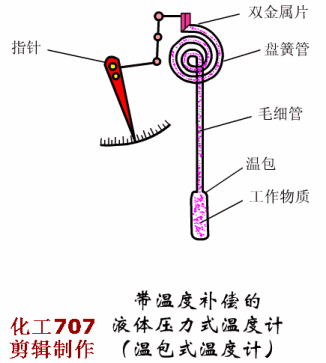
Features:
It has the characteristics of small temperature probe, high sensitivity, linear scale and long life.
Pressure gauge
Sixteen, spring tube pressure gauge
The working principle of the spring tube pressure gauge is: an oval spring tube made of phosphor bronze is installed in the case, one end of the tube is fixed and connected to the trap, and the other end is closed and connected with the connecting rod and the lever. The pointer is fixed to the pinion shaft. When the spring tube is compressed, it expands from an ellipse to a circular shape, forcing the spring tube to extend outward. The higher the pressure, the greater the extension. This action is transmitted to the pointer through the lever, lever, sector gear, pinion, and the pointer is rotated. The pressure inside the container. When there is no pressure in the container, the spring tube returns to its original position and the pointer returns to zero. The pointer is indicated as gauge pressure and the unit scale should be MPa.
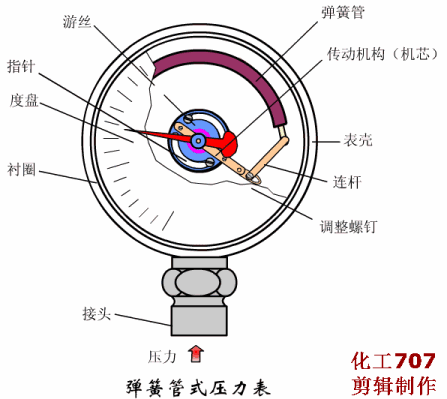
Features:
The spring tube type pressure gauge has the characteristics of simple structure, low cost, high precision, convenient carrying, convenient installation and use, wide measuring range, etc., so the application is very scarce. It is composed of a case, a spring tube, a fixed end, a tie rod, a fan gear, a pinion, a pointer, a hairspring, a pipe joint and the like.
Seventeen, electric contact pressure meter
The electric contact pressure gauge is based on the spring tube in the measuring system under the pressure of the measured medium, forcing the end of the spring tube to produce a corresponding elastic deformation-displacement, by means of the transmission of the pull rod through the gear transmission mechanism and amplified, by the fixed gear The indication (along with the contacts) indicates the measured value on the dial. At the same time, when it comes into contact with the contact (upper or lower limit) of the set pointer (the upper or lower limit), the circuit in the control system can be disconnected or turned on to achieve automatic control and transmission. The purpose of the letter alarm.
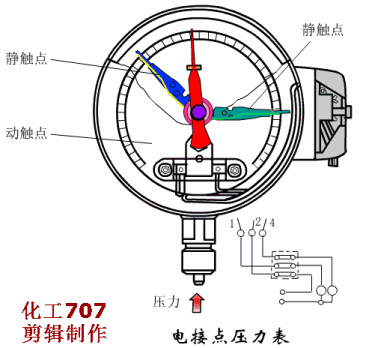
Features:
On the electrical contact signal pin of the electric contact pressure gauge device, an adjustable permanent magnet is installed, which can increase the contact suction force and accelerate the contact action, thereby making the contact contact reliable and eliminating the arc, and effectively avoiding the vibration of the instrument due to the working environment. Or medium pressure pulsation causes frequent contact closure. Therefore, the electric contact pressure gauge has the advantages of reliable action, long service life, and large contact switch power.
18. Capacitive pressure sensor
It generally uses a circular metal film or a metallized film as an electrode of a capacitor. When the film is deformed by pressure, the capacitance formed between the film and the fixed electrode changes, and the output can be related to the voltage through the measuring circuit. electric signal. Capacitive pressure sensors are pole-to-change capacitive sensors that can be divided into single-capacitor pressure sensors and differential capacitive pressure sensors.
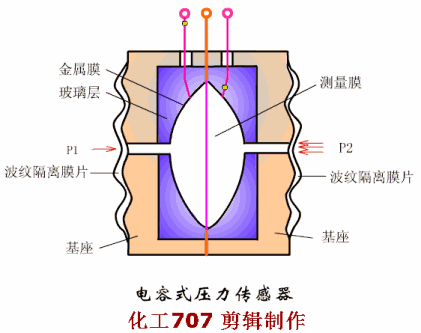
Single capacitive pressure sensor
It consists of a circular film and a fixed electrode. The film is deformed under pressure to change the capacity of the capacitor, and its sensitivity is roughly proportional to the area and pressure of the film and inversely proportional to the tension of the film and the distance from the film to the fixed electrode. Another type of fixed electrode adopts a concave spherical shape, and the diaphragm is a peripherally fixed tensioning plane, and the diaphragm can be made by a plastic metal plating layer. This type is suitable for measuring low pressure and has a high overload capacity. It is also possible to use a single-capacitance pressure sensor with a piston moving pole diaphragm to measure high voltage. This type reduces the direct compression area of ​​the diaphragm to increase sensitivity with a thinner diaphragm. It is also packaged with various compensation and protection sections and amplifier circuits to improve immunity to interference. This sensor is suitable for measuring dynamic high pressures and telemetry of aircraft. Single-capacitor pressure sensors are also available in microphone (ie microphone) and stethoscope models.
Differential capacitive pressure sensor
Its pressurized diaphragm electrode is located between two fixed electrodes to form two capacitors. Under the action of pressure, the capacity of one capacitor increases and the other decreases accordingly, and the measurement result is output by the differential circuit. Its fixed electrode is made by plating a metal layer on the concave curved glass surface. When overloaded, the diaphragm is protected by a concave surface without breaking. Differential capacitive pressure sensors have higher sensitivity and better linearity than single-capacitance type, but they are difficult to process (especially difficult to ensure symmetry), and can not achieve isolation of the gas or liquid to be measured, so it is not suitable for working in corrosion. Sexual or impurity fluid.
19. Strain gauge pressure sensor
Strain gauge pressure sensor is a kind of sensor used in pressure sensor. It is generally used to measure large pressure. It is widely used to measure internal pressure of pipeline, pressure of internal combustion engine gas, differential pressure and injection pressure, engine and missile test. The pulsating pressure, as well as the fluid pressure in various fields.
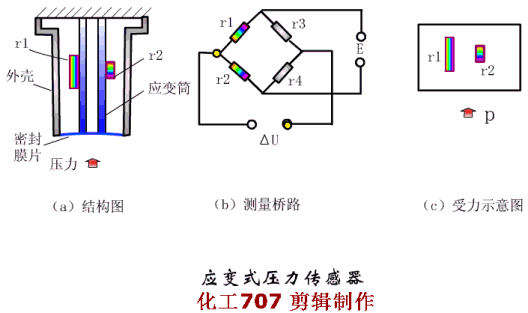
Features:
The most commonly used strain gauges are adhesive strain gauges (ie strain gauges). Its main disadvantages are small output signal, narrow linear range, and poor dynamic response (see resistance strain gauges, semiconductor strain gauges). However, due to the small size of the strain gauges, the commercially available strain gauges are available in a variety of sizes, and the flexible sensing elements can be flexibly designed to suit various applications. Therefore, strain gauge pressure sensors made of strain gauges are still widely used. Applications. According to the structure of the elastic sensitive element, the strain gauge pressure sensor can be roughly divided into four types: strain tube type, diaphragm type, strain beam type and combined type.
Twenty, U-type pressure gauge
The principle of use of the pressure gauge: Before the U-type pressure gauge is not connected to the pressure measurement point, the liquid level on both sides of the U-shaped glass tube is level at the zero mark line. When one end of the U-shaped tube is connected to the pressure measuring point, the liquid level in the U-shaped tube changes. If the liquid level on the side connected to the pressure measuring point drops, the pressure at the pressure measuring point is positive pressure, and vice versa.
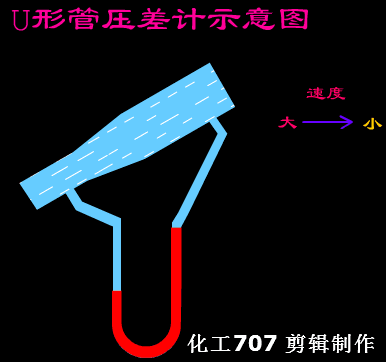
Features:
Because of its simple structure, sturdiness and durability, low cost and long service life, it can be used for almost permanent use, easy to read, reliable data, no external power supply and no need to consume any energy. Therefore, it has been widely used in various scientific research processes in industrial production.
Twenty-one, two-level differential pressure gauge
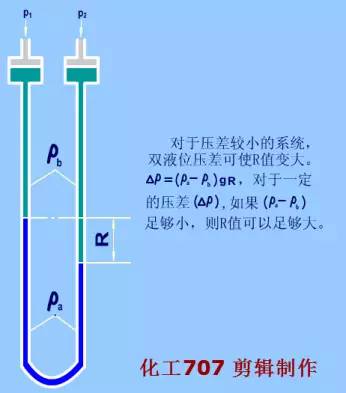
Level gauge
Twenty-two, differential pressure level gauge A
A meter that calculates the level (differential pressure) of an object in a container by measuring the pressure difference at two different points in the container. Conventional differential pressure transmitters measure the level by measuring the level pressure in the vessel. For example, a 500 mm water column corresponds to a pressure of 500 mmH20. However, in many applications, there is additional vapor pressure above the liquid. Since vapor pressure is not part of the level measurement, it is necessary to use a pressure tube and a capillary with a seal to counteract its presence.

Features:
Although the double flange differential pressure level system is a mature and reliable technology, it has been difficult to apply in high-profile containers and towers. Because these require longer capillaries for easy installation, too long a capillary tube makes the pressure transfer too large and becomes more pronounced when the ambient temperature changes greatly. At the same time, the installation process is relatively high, and the pressure pipe may not be reliable, which is a very serious problem.
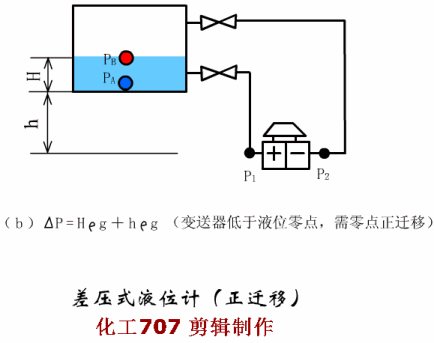
Differential pressure level gauge B

Differential pressure level gauge C
Twenty-three, ultrasonic measurement level gauge
The ultrasonic level gauge is a digital level gauge controlled by a microprocessor. In the measurement, the ultrasonic pulse is emitted by the sensor (transducer), and the sound wave is reflected by the liquid surface and then received by the same sensor or ultrasonic receiver, converted into an electrical signal by the piezoelectric crystal or magnetostrictive device, and transmitted and received by the sound wave. The time between the time to calculate the distance from the sensor to the surface of the liquid being measured. Due to the non-contact measurement, the measured medium is almost unlimited and can be widely used for the measurement of various liquid and solid materials.
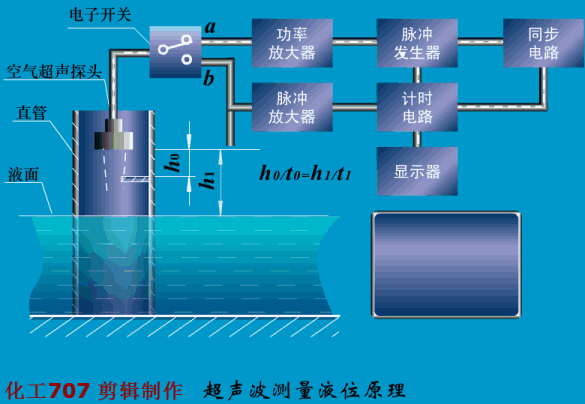
Features:
1. It has strong anti-interference. The upper and lower limit nodes and online output adjustment can be set arbitrarily, with on-site display, and the analog quantity, switch quantity and RS485 output can be selected to facilitate the interface with related facilities.
2. Use polypropylene waterproof case. The shell is small and quite strong, and has excellent chemical resistance. For inorganic compounds, except for acid, alkali and salt solutions, almost all of them have no destructive effect except for strong oxidizing materials, and almost all solvents are at room temperature. It is insoluble, and can be used on a medium such as an alkane, a hydrocarbon, an alcohol, a phenol, an aldehyde or a ketone.
3. Light weight, no scaling, no pollution to the medium.
4. Non-toxic. It can be used for equipment installation in medicine and food industry, and it is very convenient to repair.
Twenty-four, capacitive level gauge
Capacitive level gauges measure the change in capacitance to measure the level of the liquid level. It is a metal rod inserted into a liquid container, the metal rod acts as one pole of the capacitor, and the container wall acts as the other pole of the capacitor. The medium between the two electrodes is the liquid and the gas above it. Since the dielectric constant ε1 of the liquid and the dielectric constant ε2 on the liquid surface are different, for example, ε1>ε2, the total dielectric constant value between the two electrodes of the capacitive liquid level gauge increases as the liquid level rises. Therefore, the capacitance is increased. Conversely, as the liquid level drops, the ε value decreases and the capacitance decreases. Therefore, the capacitive level gauge can measure the level of the liquid level by the change in capacitance between the two electrodes. The sensitivity of the capacitance level gauge depends mainly on the difference between the two dielectric constants. Moreover, only the constant ε1 and ε2 can ensure the accurate measurement of the liquid level. Because the measured medium has conductivity, the metal rod electrode has an insulating layer covering. . The capacitance level gauge is small in size and easy to achieve remote transmission and adjustment. It is suitable for liquid level measurement of corrosive and high pressure media.

Features:
Its good structure and installation method can be applied to high temperature, high pressure, strong corrosion, easy crystallization, anti-clogging, anti-freezing and solid powdery, granular materials. It can measure the liquid level of strong corrosive medium, measure the liquid level of high temperature medium, measure the liquid level of sealed container, and has nothing to do with the viscosity, density and working pressure of the medium.
Lithium Battery Cr9V,Lithium Battery 9V,9V Lithium Battery,9V Lithium Battery Pack
Jiangmen Hongli Energy Co.ltd , https://www.honglienergy.com